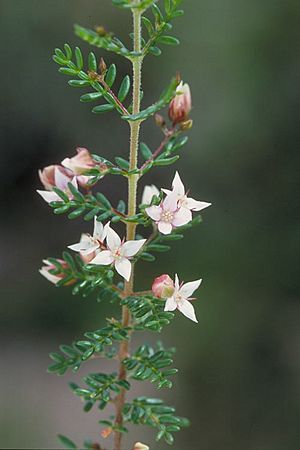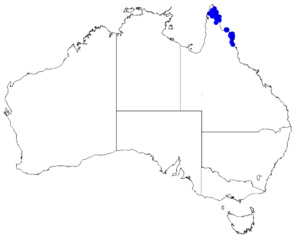Boronia alulata facts for kids
Quick facts for kids Boronia alulata |
|
|---|---|
 |
|
| Scientific classification | |
 |
|
| Occurrence data from Australasian Virtual Herbarium |
Boronia alulata is a special plant that belongs to the citrus family, just like oranges and lemons! It's a type of shrub that grows only in one specific place: the Cape York Peninsula in Australia. This plant is known for its many branches, leaves that look like feathers, and pretty pink or white flowers with four petals.
Contents
What Does Boronia alulata Look Like?
Boronia alulata is an upright shrub, which means it grows straight up. It can reach about 3 meters (or 10 feet) tall and has many branches. When the plant is young, these branches are covered in tiny, star-shaped hairs that are white or yellow. As the plant gets older, these hairs disappear, and the branches become smooth.
Leaves and Flowers
Its leaves are quite interesting. They are called "pinnate" leaves, which means they look a bit like a feather, with smaller leaf parts called "leaflets" arranged along a central stem. Each leaf can have anywhere from five to seventeen of these small leaflets. The underside of these leaflets is very hairy. The leaflet at the very end of the leaf is usually the biggest, about 3 to 13 millimeters long and 1 to 4 millimeters wide.
The flowers of Boronia alulata are pink or white. They grow in groups of up to seven flowers where the leaves meet the stem (this spot is called a leaf axil). Each group of flowers grows on a stalk called a peduncle, which can be 1 to 30 millimeters long. Each individual flower then has its own smaller stalk, called a pedicel, about 3 to 13 millimeters long.
Flower Parts
Each flower has four narrow, triangle-shaped parts called sepals, which are about 2 to 5 millimeters long. It also has four petals, which are smooth and mostly 5 to 7 millimeters long. These petals might have some hairs on the outer parts of their upper surface. Inside the flower, there are eight stamens (the parts that produce pollen), and they are different lengths. The shorter stamens are found opposite the petals. After the flowers, the plant produces shiny, smooth fruits that are 3 to 6 millimeters long and about 2 millimeters wide.
How Boronia alulata Got Its Name
The plant Boronia alulata was first officially described in 1863 by a scientist named George Bentham. He used notes from an earlier, unpublished description by Daniel Solander. This description was then published in a book called Flora Australiensis.
Meaning of the Name
The second part of the plant's name, alulata, is a special scientific term called a specific epithet. It comes from a Latin word, alatus, which means "winged." So, alulata is a smaller version of that, meaning "with narrow wings."
Where Does Boronia alulata Grow?
This type of boronia plant is endemic to the Cape York Peninsula in Australia. This means it naturally grows only in this specific area and nowhere else in the world. You can find it growing in woodlands and areas with low, shrubby plants called heathlands. It grows as far south as near Cooktown.
Is Boronia alulata Protected?
The good news is that Boronia alulata is currently classified as "least concern" by the Queensland Government under their Nature Conservation Act 1992. This means that, for now, there are plenty of these plants, and they are not considered to be in danger of disappearing.

